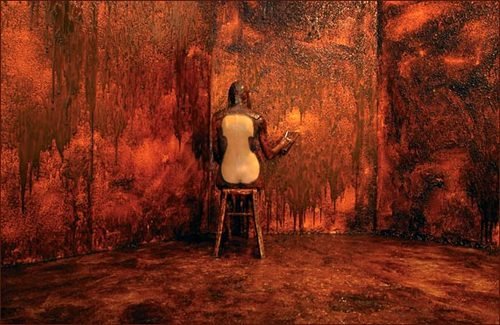Gorge(I)
dal 6/10/2006 al 6/1/2007
Segnalato da
Ido Bar-El
Orla Barry
Diane Bogaerts
Louise Bourgeois
Berlinde de Bruyckere
Peter Buggenhout
Thierry De Cordier
Christophe Denys
Marlene Dumas
James Ensor
Erki De Vries
Tim Vets
Pascale Gijsemans
Victor Hugo
Frida Kahlo
Marilou van Lierop
Bracha L. Ettinger
Alice Maher
Ana Mendieta
Maryam Najd
Ans Nys
Erna Omarsdottir
Johann Johannsson
Constant Permeke
Haleh Redjaian
Robert Seidel
Alda Snopek
Merlin Spie
Boris Debackere
Pierre Fatumbi Verger
Pe Vermeersch
Ellen Vrijsen
Francesca Woodman
Sofie Van Loo
6/10/2006
Gorge(I)
Koninklijk Museum voor Schone Kunsten, Anvers
Oppression and relief in art. It is a group exhibition that was not developed from a predetermined theme or concept; neither does it present an art-historical overview. The works do create a border-linking "in-between zone" that does not insinuate a state of equilibrium. Work by contemporary artists is confronted with art from the 19th: Louise Bourgeois, Berlinde de Bruyckere, Marlene Dumas, James Ensor, Frida Kahlo, Ana Mendieta...

Oppression and relief in art
Curated by Sofie Van Loo
Art that takes you by the throat... When things start to turn
Both the sense of oppression and the sense of relief we situate in the throat. Gorge(l) shows art that takes you by the artistic throat in different ways. One of the major 'throat artists' of the 20th-century art is Frida Kahlo (1907-1954). In her self-portraits, she never expresses panic and frightening oppression through the face, but through the throat, by choking it with ribbons and thorn collars. However, from that same throat she also suggests links - with the environment and nature - that help in causing an insufferable situation to topple.
An in-between zone
It is a group exhibition that was not developed from a predetermined theme or concept; neither does it present an art-historical overview. The works were selected because of their intensity and the fact that they deal with intensity, 'floating' between oppression and relief, between something that emerges and fades again, between bottling up and expansiveness, between something that shrinks and expands, between something that opens and closes, between breathing in and breathing out, between something that goes up and comes down again. These works do create a border-linking "in-between zone" that does not insinuate a state of equilibrium. It is an artistic adventure midway between being "seized by the throat" and "diving into the sea'".
Toppling in art
The exhibition focuses on a specific association with toppling in art. Toppling occurs at a moment when things start to turn; when the tension floating in the air descends and becomes (in)tolerable. For the sake of convenience, from the angle of western art it may be stated that the toppling is often purged from the image [conceptual art is often clean, hygienic art) or is emphasized (trail-blazing art, romanticism, drama etc.). A more rational approach is set against a more sensitive approach. The desire to continue making that distinction is rather characteristic of western art.
Between too early and too late
Western art has also produced different ways of dealing with toppling, as a result of which toppling does not have to result in '"the fall' "or the evolution from one state to the other, but can precisely lead to floating in between. The latter can be described as a border-linking association withtoppling, the theory of artist and psychoanalyst Bracha L. Ettinger. who wrote: Art links the time of too-early to the time of too-late and plants them in the world’s time. The works of art in, Gorge(l) link, float and hover between "too early" and "too late". Visitors experience that feeling between oppression and relief' through works of art from artists including Louise Bourgeois, Berlinde de Bruyckere, Thierry De Cordier, Marle'ne Dumas, James Ensor, Frida Kahlo, Erna Omarsdo'ttir, Robert Seidel, Alda Snopek, Merlin Spie and Pe' Vermeersch.
Confrontation
At certain places in the exhibition, work by contemporary artists is confronted with art from the 19th and the early 20th century. Following on from Beaufort, Maman, the largest spider by Louise Bourgeois (1911) was placed on James Ensor's grave in Mariakerke. In this exhibition, a smaller wall spider by Louise Bourgeois, Spider IV, ,is confronted with Ensor's Adam en Eva uit het paradijs verjaagd, [Adam and Eve expelled from Paradise] (1887). Not because James Ensor also drew and etched spiders, but because of the comparable intensity of the two works: it is a seething intensity, both infective and literally physically touching.
PUBLICATION
Exhibition catalogue Dutch/English Texts by Sofie Van Loo, and Bracha L. Ettinger
300 p., 20 x 30 cm Published by Luc Derycke : 40 €
Participating artists: Ido Bar-El, Orla Barry, Diane Bogaerts, Louise Bourgeois, Berlinde de Bruyckere, Peter Buggenhout, Thierry De Cordier, Christophe Denys, Marlene Dumas, James Ensor, Erki De Vries/ Tim Vets, Pascale Gijsemans, Victor Hugo, Frida Kahlo, Marilou van Lierop, Bracha L. Ettinger, Alice Maher, Ana Mendieta, Maryam Najd, Ans Nys, Erna Omarsdo'ttir/ Johann Johannsson, Constant Permeke, Haleh Redjaian, Robert Seidel, Alda Snopek, Merlin Spie, Boris Debackere, Pierre Fa'tu'mbi Verger, Pe' Vermeersch, Ellen Vrijsen, Francesca Woodman
Illustration: MERLIN SPIE, LA PETITE MUSETTE, CASQUE'E (c) Merlin Spie, 2002 Photo: Lieven Herreman Location: Galerie Nadja Vilenne, Liege
Koninklijk Museum voor Schone Kunsten Antwerpen
Leopold De Waelplaats, B-2000 Anvers
HOURS: Tuesday to Saturday from 10 am to 5 pm; on Sunday from 10 am to 6 pm. The Museum is closed on Mondays, the 1st and 2nd of January, the 1st of May, Ascension, and Christmas Day.
ADMISSION FEES: €6 / €4; Gorge(l): €8 / €6



